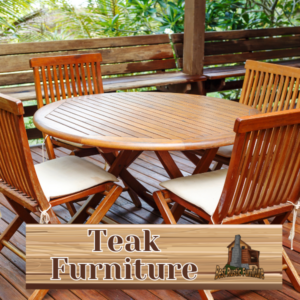
Step back in time and explore the rich history of rustic furniture. This timeless style has captivated people for centuries with its simplicity, natural materials, and beautiful craftsmanship. From its humble beginnings to its enduring appeal today, rustic furniture has made an indelible mark on interior design.
Key Takeaways:
- Rustic furniture has a long and fascinating history.
- It is known for its use of natural materials and beautiful craftsmanship.
- Rustic furniture has remained popular throughout the years due to its timeless charm and connection to nature.
- Exploring the history of rustic furniture provides insight into its enduring appeal.
- Whether in traditional rustic settings or modern spaces, rustic furniture adds a unique touch of beauty and warmth.
Exploring Rustic Furniture: Origins and Characteristics
Rustic furniture is a style that emerged in the 19th century, characterized by its use of natural materials and craftsmanship. It has remained a popular design choice throughout the 20th century, with modern interpretations still incorporating the same essential elements.
The rustic style is defined by its use of raw, natural materials such as wood, stone, and metal. These materials are often left unfinished or given a simple, rustic finish, highlighting their natural beauty and imperfections.
Craftsmanship is also a defining characteristic of rustic furniture. Each piece is often handcrafted, using traditional techniques passed down from generation to generation. This results in unique, one-of-a-kind pieces that showcase the skill and talent of the individual craftsman.
Throughout history, rustic furniture has been a staple in rural and mountain homes. It was popularized by the Adirondack region, known for its rich tradition of rustic furniture making. Notable figures like Ernest Stowe and Ben Davis helped to spread the influence of the Adirondack style to other regions, such as the lakes regions, Appalachians, and the Upper Midwest.
The Adirondack Influence: A Rustic Tradition
The Adirondack region has played a significant role in shaping the rustic furniture tradition. This vast and rugged area, spanning over six million acres across upstate New York, is home to countless lakes, rivers, and mountains that have inspired rustic furniture makers since the 19th century.
Notable figures like Ernest Stowe and Ben Davis brought the Adirondack style to the forefront of the movement, showcasing the beauty of the region through their designs. The Adirondack style, characterized by the use of local materials like birch bark and twigs, quickly spread to the lakes regions, Appalachians, and the Upper Midwest.
The Adirondack Museum, founded in 1957, played a significant role in preserving the region’s unique artistic heritage. Its collection of rustic furniture, including pieces from Stowe and Davis, attracts visitors from all over the world to this day.
The Adirondack style’s popularity peaked in the early 20th century, and since then, it has continued to influence contemporary rustic furniture makers. Despite its enduring appeal, the style has evolved to include new elements while retaining its rustic roots.
Today, Adirondack-inspired designs remain a hallmark of the rustic furniture tradition, celebrated by craftspeople and furniture enthusiasts alike.
Rustic Furniture Makers: From Craftsmen to Companies
As rustic furniture gained popularity, individual craftsmen began to form larger furniture companies, taking advantage of the growing demand. One of the most well-known of these companies was the Old Hickory Furniture Company, which emerged in the early 20th century and quickly became a major player in the rustic furniture market.
Founded in Indiana in 1899, the Old Hickory Furniture Company gained fame for its use of hickory saplings, which were bent and molded into unique, sturdy pieces of furniture. The company later moved to North Carolina, where it continued to produce high-quality rustic furniture for many years.
Old Hickory Furniture Company was far from the only rustic furniture maker to gain prominence during this time. As the popularity of rustic furniture continued to grow, numerous other furniture companies emerged, each with their own unique take on the rustic style. However, many of these companies failed to maintain the high level of craftsmanship that had originally propelled the rustic furniture movement forward.
Despite the challenges of mass production, many modern-day rustic furniture makers continue to prioritize hand-crafted, high-quality pieces. These artisans understand the importance of maintaining the unique character and charm of rustic furniture, and work tirelessly to ensure that each piece they create is both beautiful and durable.
Elements of Rustic Design: Texture, Finish, and Natural Forms
Rustic furniture is characterized by its use of natural materials and unique textures and finishes. From the rough bark of a tree branch to the smoothness of polished cedar, rustic furniture celebrates the beauty of the natural world. Let’s explore some of the key elements that define rustic design.
Texture
Rustic furniture is known for its textural interest. The use of raw, unpolished materials adds a sense of ruggedness and authenticity to pieces. The roughness of bark, the knobbiness of a branch, or the natural grain of wood all add tactile intrigue to rustic furniture.
Another way that texture is added to rustic pieces is through weaving. Whether it’s a rug made from natural fibers or a basket woven from branches, weaving adds a touch of pattern and texture to rustic furniture.
Finish
The finish of rustic furniture can vary widely, from unfinished and raw to highly polished and refined. Raw wood and unfinished surfaces highlight the natural beauty of the materials and give a piece a more rugged and rough-hewn look. Highly polished finishes, on the other hand, can add refinement and shine to rustic pieces.
Often, the finish of rustic furniture is chosen to complement the natural forms of the materials used. For example, bark may be left unpolished on a table leg to highlight the roughness of the wood, while the top of the table may be sanded and finished to perfection.
Natural Forms
One of the most defining features of rustic furniture is its use of natural forms. Branches, twigs, poles, and saplings all make frequent appearances in rustic pieces. Antlers and other animal parts are also sometimes incorporated into the design.
These natural elements give rustic furniture a sense of connection to the outdoors and are often used to create unique and interesting shapes. A chair made from intertwined branches or a dresser with drawer pulls made from antlers are just a few examples of how natural forms can be incorporated into rustic design.
Overall, the use of texture, finish, and natural forms helps to define the distinctive style of rustic furniture.
The Appeal of Rustic Furniture: Aesthetic and Flair
There’s something undeniably charming and captivating about rustic furniture that has made it a popular design choice for many. Its aesthetic seamlessly blends with different styles, from mid-century modern to modern rustic, making it versatile and adaptable. But what is it about rustic furniture that makes it so appealing?
At the heart of the rustic tradition is craftsmanship, passed down through generations of individual craftsmen. Each piece is a one-of-a-kind creation, imbued with a sense of history and authenticity. This level of craftsmanship lends a sense of flair to each piece, one that is not often found in mass-produced furniture.
But rustic furniture is more than just unique pieces. Its natural origins and use of natural materials make it a nod to the beauty and simplicity of nature. This connection to the outdoors is what sets rustic furniture apart from other styles and gives it its enduring appeal.
From its origins in traditional rustic settings to its place in modern homes, the rustic look has continued to captivate. Its ability to transform a space while bringing in the beauty of nature has made it a go-to choice for many looking to create a warm and inviting atmosphere.
Whether you’re drawn to the rustic tradition or the modern take on this timeless style, there’s no denying the appeal of rustic furniture. Its individual craftsmen, use of natural materials, and sense of flair continue to make it a popular design choice that will never go out of style.
Decorative and Functional: Rustic Furniture in Everyday Living
One of the great advantages of rustic furniture is its versatility as both decorative and functional pieces. From chairs and tables to dressers and settees, rustic furniture can be incorporated into any living space, bringing a sense of warmth and charm. Whether you prefer a traditional look or something more contemporary, pieces of rustic furniture can be easily integrated into your home.
The use of natural materials and textures gives rustic furniture a unique appeal. Weaving, rugs, baskets, and blankets are commonly incorporated into rustic design, adding a cozy touch to any living space. When combined with natural woods and finishes, these elements create a warm and inviting atmosphere.
When it comes to seating, rustic chairs and benches are a popular choice. Made from natural materials like wood, they blend seamlessly with rustic decor. Rustic tables, on the other hand, can be used in a variety of settings. Whether as a coffee table or dining table, they create a focal point in any room.
Rustic dressers and settees are also common choices for bedrooms and living rooms. With their unique textures and finishes, they add character to any space. In addition, they are often highly functional, providing ample storage space and comfortable seating.
Another aspect of rustic furniture is its ability to showcase natural objects. Branches, twigs, poles, cedar, antler, and saplings are often incorporated into the design of rustic furniture. This feature makes each piece of furniture a unique work of art.
| Decorative Pieces of Rustic Furniture: | Functional Pieces of Rustic Furniture: |
|---|---|
| Weaving | Chairs |
| Rugs | Tables |
| Baskets | Dressers |
| Blankets | Settees |
Overall, rustic furniture offers a blend of decorative and functional elements that make it a popular choice for any home. Its unique textures, natural forms, and finishes make each piece a work of art that can add character and charm to your living space.
Rustic Furniture Today: Continuing the Legacy
While rustic furniture has a long history, it continues to remain relevant in modern times. The rustic look is still in high demand, with many individuals seeking furniture that is unfinished or incorporates natural materials. In fact, the trend towards ‘green’ and environmentally friendly living has only increased the appeal of rustic furniture.
And it’s not just in traditional rustic settings that this furniture style shines. Rustic pieces have found their place in suburban homes, adding a touch of charm and character to modern decor. The refinement of rustic pieces has also led to increased durability, making them a practical choice for everyday living.
The Adirondack Mountains, with their rich history of rustic furniture making, continue to influence the style to this day. Handcrafted pieces, created by individual craftsmen, remain highly valued for the unique touch they bring to any space. Whether it’s a hand-crafted cedar seat, a bark-twig weave rug, or an antler basket filled with blankets, rustic furniture pieces add warmth and personality to any room.
Conclusion
In conclusion, the history of rustic furniture is a journey through time, tracing its origins from the 19th century to its enduring popularity today. The use of natural materials and craftsmanship defines the rustic style, with the Adirondack region playing a prominent role in its development. From individual craftsmen to large furniture companies, rustic furniture has evolved to remain relevant in modern times, with its unique charm and connection to the natural world. Today, rustic furniture continues to captivate with its appeal in both traditional rustic settings and contemporary spaces. Its unfinished look, incorporation of natural forms such as bark, branches, and antlers, and handcrafted, hand-crafted designs all contribute to its popularity. Rustic furniture is not only decorative but also functional, with various types of furniture including chairs, tables, dressers, settees, and woven rugs, baskets, and blankets. In short, rustic furniture is a style that offers a connection to nature and the beauty of the outdoors. Its continued legacy is a testament to its timeless appeal that will continue to enliven any living space or home.
FAQ
What is the history of rustic furniture?
Rustic furniture has a rich history that dates back to the 19th century. It emerged as a style that celebrates the use of natural materials and embodies the craftsmanship of skilled artisans.
What are the defining characteristics of rustic furniture?
Rustic furniture is known for its use of natural materials, such as wood and stone, and its emphasis on craftsmanship. It often features textures, finishes, and natural forms, such as bark, branches, and twigs.
What is the influence of the Adirondack region on rustic furniture?
The Adirondack region has had a significant influence on the development of rustic furniture. Notable figures like Ernest Stowe and Ben Davis played a role in establishing the region as a hub for the rustic tradition, which later spread to other areas like the lakes regions, Appalachians, and the Upper Midwest.
How did rustic furniture transition from individual craftsmen to furniture companies?
Over time, rustic furniture production shifted from being primarily handmade by individual craftsmen to being manufactured by larger furniture companies. One prominent example is the Old Hickory Furniture Company, which played a significant role in mass-producing rustic furniture, particularly in Indiana and North Carolina.
What are the key elements of rustic design?
Rustic design incorporates various elements, including texture, finish, and natural forms. This can include the use of bark, branches, twigs, poles, cedar, antler, and saplings to create a unique and nature-inspired look.
What makes rustic furniture appealing?
Rustic furniture appeals to many because of its aesthetic and flair. It can fit into different design styles, such as mid-century modern or modern rustic, and its uniqueness lies in the craftsmanship of individual artisans who create one-of-a-kind pieces.
How is rustic furniture used in everyday living?
Rustic furniture serves both decorative and functional purposes. It includes various pieces such as chairs, tables, dressers, and settees that can enhance any space. Additionally, elements like weaving, rugs, baskets, and blankets add to the overall rustic design.
How has rustic furniture evolved in modern times?
Rustic furniture has continued to evolve and remain relevant in modern times. It is popular for its unfinished look, which brings a rustic charm to suburban settings. The refinement of rustic furniture ensures its durability, and it continues to be handcrafted, capturing the essence of the Adirondack Mountains and the natural world.






